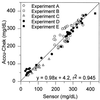Continuous amperometric monitoring of glucose in a brittle diabetic chimpanzee with a miniature subcutaneous electrode
- PMID: 9600973
- PMCID: PMC27726
- DOI: 10.1073/pnas.95.11.6379
Continuous amperometric monitoring of glucose in a brittle diabetic chimpanzee with a miniature subcutaneous electrode
Abstract
The performance of an amperometric biosensor, consisting of a subcutaneously implanted miniature (0.29 mm diameter, 5 x 10(-4) cm2 mass transporting area), 90 s 10-90% rise/decay time glucose electrode, and an on-the-skin electrocardiogram Ag/AgCl electrode was tested in an unconstrained, naturally diabetic, brittle, type I, insulin-dependent chimpanzee. The chimpanzee was trained to wear on her wrist a small electronic package and to present her heel for capillary blood samples. In five sets of measurements, averaging 5 h each, 82 capillary blood samples were assayed, their concentrations ranging from 35 to 400 mg/dl. The current readings were translated to blood glucose concentration by assaying, at t = 1 h, one blood sample for each implanted sensor. The rms error in the correlation between the sensor-measured glucose concentration and that in capillary blood was 17.2%, 4.9% above the intrinsic 12.3% rms error of the Accu-Chek II reference, through which the illness of the chimpanzee was routinely managed. Linear regression analysis of the data points taken at t>1 h yielded the relationship (Accu-Chek) = 0. 98 x (implanted sensor) + 4.2 mg/dl, r2 = 0.94. The capillary blood and the subcutaneous glucose concentrations were statistically indistinguishable when the rate of change was less than 1 mg/(dl. min). However, when the rate of decline exceeded 1.8 mg/(dl.min) after insulin injection, the subcutaneous glucose concentration was transiently higher.
Figures



Similar articles
-
Calibration of a subcutaneous amperometric glucose sensor. Part 1. Effect of measurement uncertainties on the determination of sensor sensitivity and background current.Biosens Bioelectron. 2002 Aug;17(8):641-6. doi: 10.1016/s0956-5663(01)00306-2. Biosens Bioelectron. 2002. PMID: 12052349 Clinical Trial.
-
Accuracy of a Factory-Calibrated, Real-Time Continuous Glucose Monitoring System During 10 Days of Use in Youth and Adults with Diabetes.Diabetes Technol Ther. 2018 Jun;20(6):395-402. doi: 10.1089/dia.2018.0150. Epub 2018 Jun 14. Diabetes Technol Ther. 2018. PMID: 29901421 Free PMC article.
-
Electrochemistry in diabetes management.Acc Chem Res. 2010 Jul 20;43(7):963-73. doi: 10.1021/ar9002015. Acc Chem Res. 2010. PMID: 20384299
-
Overview of a novel sensor for continuous glucose monitoring.J Diabetes Sci Technol. 2013 Jul 1;7(4):808-14. doi: 10.1177/193229681300700402. J Diabetes Sci Technol. 2013. PMID: 23911161 Free PMC article. Review.
-
Amperometric glucose sensors: sources of error and potential benefit of redundancy.J Diabetes Sci Technol. 2010 Jan 1;4(1):221-5. doi: 10.1177/193229681000400127. J Diabetes Sci Technol. 2010. PMID: 20167187 Free PMC article. Review.
Cited by
-
Determination of hemoglobin A1c and fasting blood glucose reference intervals in captive chimpanzees (Pan troglodytes).J Am Assoc Lab Anim Sci. 2011 Mar;50(2):165-70. J Am Assoc Lab Anim Sci. 2011. PMID: 21439208 Free PMC article.
-
Electrochemical sensor array for glucose monitoring fabricated by rapid immobilization of active glucose oxidase within photochemically polymerized hydrogels.J Diabetes Sci Technol. 2007 May;1(3):366-71. doi: 10.1177/193229680700100308. J Diabetes Sci Technol. 2007. PMID: 19885091 Free PMC article.
-
Biocompatible materials for continuous glucose monitoring devices.Chem Rev. 2013 Apr 10;113(4):2528-49. doi: 10.1021/cr300387j. Epub 2013 Feb 7. Chem Rev. 2013. PMID: 23387395 Free PMC article. Review. No abstract available.
-
Immobilizing enzymes onto electrode arrays by hydrogel photolithography to fabricate multi-analyte electrochemical biosensors.ACS Appl Mater Interfaces. 2010 Mar;2(3):748-55. doi: 10.1021/am9007819. ACS Appl Mater Interfaces. 2010. PMID: 20356276 Free PMC article.
-
In vitro, in vivo and post explantation testing of glucose-detecting biosensors: current methods and recommendations.Biomaterials. 2007 Sep;28(25):3687-703. doi: 10.1016/j.biomaterials.2007.03.034. Epub 2007 Apr 19. Biomaterials. 2007. PMID: 17524479 Free PMC article. Review.
References
-
- Arnold M A. Curr Opin Biotechnol. 1996;7:46–49. - PubMed
-
- Spanner G, Niessner R. Fresenius’ J Anal Chem. 1996;355:327–328. - PubMed
-
- Berger A J, Itzkan I, Feld M S. Spectrochim Acta, Part A. 1997;53:287–292. - PubMed
-
- Heise H M. Horm Metab Res. 1996;28:527–534. - PubMed
-
- Kohl M, Essenpreis M, Cope M. Phys Med Biol. 1995;40:1267–1287. - PubMed
Publication types
MeSH terms
Substances
Grants and funding
LinkOut - more resources
Full Text Sources
Other Literature Sources
Medical

